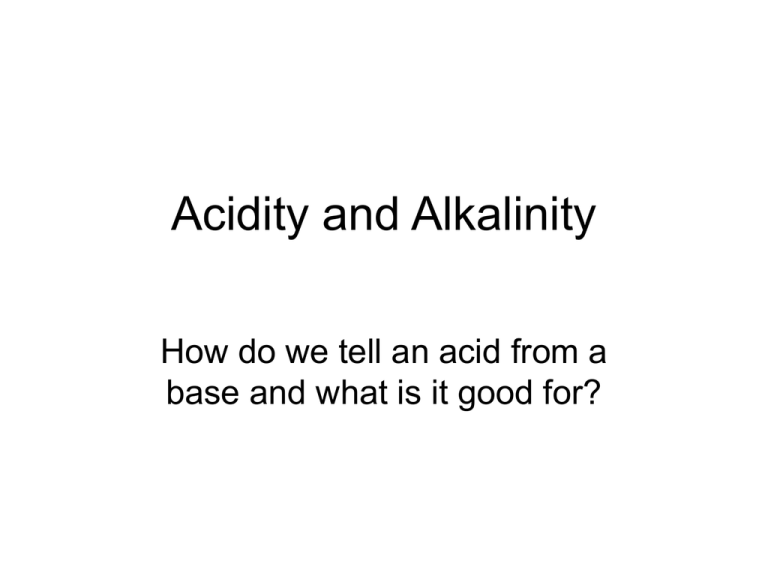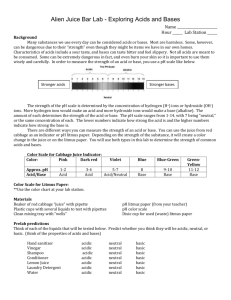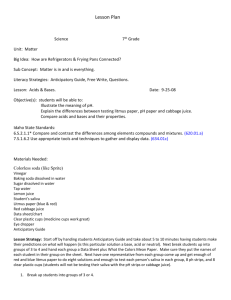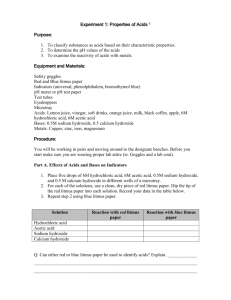Acidity and Alkalinity
advertisement

Acidity and Alkalinity How do we tell an acid from a base and what is it good for? What is an acid? • A substance that donates a hydrogen ion (proton) when dissolved in water. • The hydrogen ion goes with water to make hydronium (H3O) • It tastes sour What is a base? • A substance that accepts a hydronium ion (H30) when in water. • It releases hydroxide ions OH- when dissolved in water • It tastes bitter • Examples include: Ammonia, sodium hydroxide and baking soda • What about bases make them react with acids to make salt? • Tomato is at 4 on the pH scale and lemon is at 2. How many times more acidic than tomato do you think the lemon is? • 100times more! Each step on the pH scale works out to be 10 times more acidic or basic! Indicators • There are several substances which react with acids and bases • They can tell us whether the substance is acidic or basic • Examples include: litmus paper, bromothymol blue and red cabbage juice Litmus paper • Litmus paper is used to tell whether a solution is an acid or a base. • It cannot tell you how strong the acid or base is • It comes in 2 colours: red and blue • Red paper turns blue in a base but will not change otherwise • Blue paper turns red in an acid but will not change otherwise. • Why do you think we sometimes need to test an acid or a base with both colours of paper before knowing what it is? Bromothymol Blue • Bromothymol Blue is a liquid that reacts in acids and bases • It turns yellow in acid and blue in base • It takes on a green tinge in a neutral solution • It is good for telling the exact pH when the substance is only slightly acidic or basic Red Cabbage Juice • Red cabbage juice is another liquid indicator that will change colour in an acid or base • It can be made by boiling red cabbage and keeping the juice • It will change a wide range of colours and so can be used to accurately determine the aciditiy of a substance. Classify each of the following as either an acid or a base Bibliography of images • • • • • • • • • • • • http://science.nayland.school.nz/SimonPa/Webpage/Year10/Acid_base_images/acids _and_bases_phscale.jpg http://www.mhhe.com/physsci/chemistry/chang7/esp/folder_structure/cr/m3/s3/assets /images/crm3s3_1.jpg http://www.biologycorner.com/resources/dissociation.gif http://oldwww.mtlsd.org/senior/science/JPtachcinski/Lab_Proc/Basic%20Science%20 Lab%20Techniques_files/litmus.jpe http://www.farm.ucl.ac.be/tpao/instrumentation/titrimetrie/Indicateurs/HBtB.jpg http://www.erowid.org/archive/rhodium/chemistry/equipment/pictures/ph-cabbage.jpg http://wetheadmedia.com/wp-content/uploads/pictures/2009/03/Arm-Hammer-BakingSoda.jpg http://cojent7.files.wordpress.com/2010/05/coca-cola.jpg http://www.bized.co.uk/images/battery.jpg http://beautifullyused.com/wp-content/uploads/2009/03/lemon.jpeg http://www.mochadad.com/wp-content/uploads/2008/12/soap-on-a-rope.jpg http://www.savingwithshellie.com/wp-content/uploads/2009/04/ammonia.jpg







![2[<---Click on link] - socialstudiesguy.com](http://s2.studylib.net/store/data/005453708_1-895a35768b91cdab66a77df6b59f9930-300x300.png)



